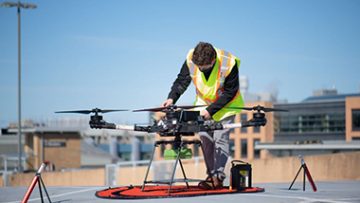 The “Campus as a Living 5G Lab” created by the UBC-Rogers Partnership is being used to research the viability of employing drones in cities—which UBC models—to safely deliver packages like prescription drugs. 5G networks can be used to control drones beyond the visual line of sight (BVLOS).
The “Campus as a Living 5G Lab” created by the UBC-Rogers Partnership is being used to research the viability of employing drones in cities—which UBC models—to safely deliver packages like prescription drugs. 5G networks can be used to control drones beyond the visual line of sight (BVLOS).
The project, led by Dr. Walter Merida of MéridaLabs, is a collaboration among UBC, Rogers, Honeywell, and Victoria-based InDro Robotics. Some of the questions the team is exploring include:
- What weights and sizes of packages can be delivered, and over what range?
- How many drones can be operated autonomously at a single time over the network?
- Does 5G connectivity vary with altitude?
- Can an Unmanned Traffic Management system – to minimize the potential for conflict with low-flying traditional aircraft – be successfully deployed and demonstrated in a mini-city?
- Can AI use data from previous flights to accurately predict energy demands for future missions? How efficient (and cost-effective) is a hydrogen fuel cell drone when compared with one powered by lithium-polymer batteries?
The drones and navigational software used in the project are provided by InDro Robotics. Canada’s first drone flight over a 5G network was conducted by the team at UBC-Vancouver in April 2021.
This story was adapted from a longer story on the InDro Robotics website.